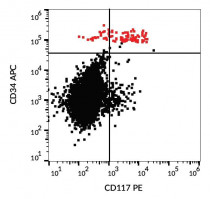ARG54188
anti-CD117 / c-Kit antibody [104D2] (PE)
anti-CD117 / c-Kit antibody [104D2] (PE) for Flow cytometry and Human,Bovine,Primates
Cancer antibody; Controls and Markers antibody; Developmental Biology antibody; Immune System antibody; Neuroscience antibody; Signaling Transduction antibody
Overview
| Product Description | PE-conjugated Mouse Monoclonal antibody [104D2] recognizes CD117 |
|---|---|
| Tested Reactivity | Hu, Bov, NHuPrm |
| Tested Application | FACS |
| Specificity | The mouse monoclonal antibody 104D2 detects extracellular part of CD117 / cKit protooncogen. HLDA VI; WS Code C30 |
| Host | Mouse |
| Clonality | Monoclonal |
| Clone | 104D2 |
| Isotype | IgG1 |
| Target Name | CD117 / c-Kit |
| Immunogen | MOLM-1 megakaryocytic cells_x000D_ |
| Conjugation | PE |
| Alternate Names | PBT; C-Kit; Tyrosine-protein kinase Kit; CD antigen CD117; Mast/stem cell growth factor receptor Kit; CD117; Proto-oncogene c-Kit; SCFR; Piebald trait protein; v-kit Hardy-Zuckerman 4 feline sarcoma viral oncogene homolog; p145 c-kit; EC 2.7.10.1 |
Application Instructions
| Application Suggestion |
|
||||
|---|---|---|---|---|---|
| Application Note | * The dilutions indicate recommended starting dilutions and the optimal dilutions or concentrations should be determined by the scientist. |
Properties
| Form | Liquid |
|---|---|
| Purification Note | The purified antibody is conjugated with R-Phycoerythrin (PE) under optimum conditions. The conjugate is purified by size-exclusion chromatography and adjusted for direct use. No reconstitution is necessary. |
| Buffer | PBS, 15 mM Sodium azide and 0.2% (w/v) high-grade protease free BSA |
| Preservative | 15 mM Sodium azide |
| Stabilizer | 0.2% (w/v) high-grade protease free BSA |
| Storage Instruction | Aliquot and store in the dark at 2-8°C. Keep protected from prolonged exposure to light. Avoid repeated freeze/thaw cycles. Suggest spin the vial prior to opening. The antibody solution should be gently mixed before use. |
| Note | For laboratory research only, not for drug, diagnostic or other use. |
Bioinformation
| Database Links |
Swiss-port # P10721 Human Mast/stem cell growth factor receptor Kit |
|---|---|
| Gene Symbol | KIT |
| Gene Full Name | v-kit Hardy-Zuckerman 4 feline sarcoma viral oncogene homolog |
| Background | CD117 / c-Kit (stem cell factor receptor) is a 145 kDa receptor tyrosine kinase that regulates cell proliferation, adhesion, chemotaxis, apoptosis and other cell processes. Mutations of CD117 / c-Kit can lead to growth and progression of tumours. After binding of its ligand, SCF (stem cell factor), CD117 / c-Kit is autophosphorylated on its intracellular domains and activated. CD117 is expressed on pluripotent hematopoietic progenitor cells, mast cells and various cancer cells, e.g. acute myeloid leukemia cells. |
| Function | Tyrosine-protein kinase that acts as cell-surface receptor for the cytokine KITLG/SCF and plays an essential role in the regulation of cell survival and proliferation, hematopoiesis, stem cell maintenance, gametogenesis, mast cell development, migration and function, and in melanogenesis. In response to KITLG/SCF binding, KIT can activate several signaling pathways. Phosphorylates PIK3R1, PLCG1, SH2B2/APS and CBL. Activates the AKT1 signaling pathway by phosphorylation of PIK3R1, the regulatory subunit of phosphatidylinositol 3-kinase. Activated KIT also transmits signals via GRB2 and activation of RAS, RAF1 and the MAP kinases MAPK1/ERK2 and/or MAPK3/ERK1. Promotes activation of STAT family members STAT1, STAT3, STAT5A and STAT5B. Activation of PLCG1 leads to the production of the cellular signaling molecules diacylglycerol and inositol 1,4,5-trisphosphate. KIT signaling is modulated by protein phosphatases, and by rapid internalization and degradation of the receptor. Activated KIT promotes phosphorylation of the protein phosphatases PTPN6/SHP-1 and PTPRU, and of the transcription factors STAT1, STAT3, STAT5A and STAT5B. Promotes phosphorylation of PIK3R1, CBL, CRK (isoform Crk-II), LYN, MAPK1/ERK2 and/or MAPK3/ERK1, PLCG1, SRC and SHC1. [UniProt] |
| Research Area | Cancer antibody; Controls and Markers antibody; Developmental Biology antibody; Immune System antibody; Neuroscience antibody; Signaling Transduction antibody |
| Calculated MW | 110 kDa |
| PTM | Ubiquitinated by SOCS6. KIT is rapidly ubiquitinated after autophosphorylation induced by KITLG/SCF binding, leading to internalization and degradation. Autophosphorylated on tyrosine residues. KITLG/SCF binding enhances autophosphorylation. Isoform 1 shows low levels of tyrosine phosphorylation in the absence of added KITLG/SCF (in vitro). Kinase activity is down-regulated by phosphorylation on serine residues by protein kinase C family members. Phosphorylation at Tyr-568 is required for interaction with PTPN11/SHP-2, CRK (isoform Crk-II) and members of the SRC tyrosine-protein kinase family. Phosphorylation at Tyr-570 is required for interaction with PTPN6/SHP-1. Phosphorylation at Tyr-703, Tyr-823 and Tyr-936 is important for interaction with GRB2. Phosphorylation at Tyr-721 is important for interaction with PIK3R1. Phosphorylation at Tyr-823 and Tyr-936 is important for interaction with GRB7. |
Images (1) Click the Picture to Zoom In
Clone References








